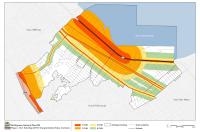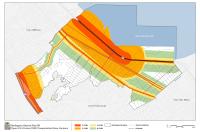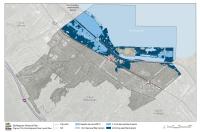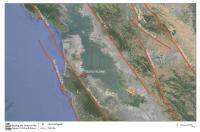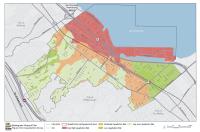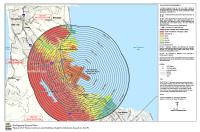Noise
Noise typically is defined as unwanted sound. Exposure to excessive noise can impact the health and quality of life of people who visit, reside in, or work in Burlingame. While people may not agree as to what constitutes particularly irksome noise, science does show that defined noise levels can cause ill health effects. Excessive noise can cause hearing loss, stress, hypertension, sleep disturbance, and fatigue.
NOISE TERMINOLOGY
dBA: Measurement unit for “a-weighted decibels,” which are commonly used for measuring environmental and industrial noise and the potential hearing damage associated noise health effects.
Equivalent Noise Level (Leq): Constant noise level that would deliver the same acoustic energy to the ear of a listener as the actual time-varying noise would deliver over the same exposure time. No “penalties” are added to any noise levels during the exposure time; Leq would be the same regardless of the time of day during which the noise occurs.
Day-Night Average Noise Level (Ldn): A 24-hour average Leq with a 10 dBA “penalty” added to noise levels during the hours of 10:00 P.M. to 7:00 A.M. to account for increased sensitivity that people tend to have to nighttime noise. Because of this penalty, the Ldn would always be higher than its corresponding 24-hour Leq (e.g., a constant 60 dBA noise over 24 hours would have a 60 dBA Leq, but a 66.4 dBA Ldn).
Community Noise Equivalent Level (CNEL): An Ldn with an additional 5 dBA “penalty” for the evening hours between 7:00 P.M. and 10:00 P.M. This is essentially a measure of ambient noise.
Sound Exposure Level or Single Event Level (SEL): A descriptor used to characterize the severity of short-duration sound events. SEL is the time-averaged, constant intensity, A-weighted sound level over a one-second reference time that would produce the same sound exposure as the actual time-varying sound over the actual exposure time. In practice, SEL is usually applied in situations where there are multiple sound events, each one having its own characteristic SEL.
Planning to safeguard the community from unhealthful noise exposure requires use of specialized noise metrics. Noise is measured on the logarithmic decibel (dBA) scale, which is used to describe short-term noise events. For the purposes of land use planning, the more specialized Community Noise Equivalent Level (CNEL) metric has been developed to account for noise levels over a 24-hour period. These noise levels can be mapped as contours that illustrate noise exposure zones. Figure CS-1 reports noise conditions in Burlingame as of 2016. Generally, the noise range of 55 to 65 dBA CNEL represents an acceptable outdoor noise environment for residential neighborhoods. Figure CS-2 identifies noise/land use compatibility criteria for Burlingame.
The primary noise sources in Burlingame are mobile sources associated with transportation infrastructure, including aircraft, trains, and motor vehicles on freeways. Those land uses affected most adversely by excessive noise—so called “sensitive” land uses—include residential care facilities, schools, hospitals, and wildlife habitat.
Land use decisions and the development review process can work to minimize noise impacts on sensitive land uses. Noise compatibility may be achieved by avoiding the location of conflicting land uses adjacent to one another using the criteria shown in Figure CS-2. For example, new residential uses generally should not be built adjacent to the freeways or rail line. Noise impacts can also be minimized by incorporating buffers and noise control features into a development project, including setbacks, landscaping, building transitions, site design/building orientation, and building construction approaches. Selection of the appropriate noise control technique will vary depending on the level of noise that needs to be reduced, as well as the location and intended land use.
| Land Use Category | Community Noise Exposure Ldn/CNEL, dB | ||||||
|---|---|---|---|---|---|---|---|
| <55 decibels | 55 decibels | 60 decibels | 65 decibels | 70 decibels | 75 decibels | 80 decibels | |
| Residential - Low Single Density Family, Duplex, Mobile Homes | normally acceptable | conditionally acceptable | conditionally acceptable | conditionally acceptable | normally unacceptable | clearly unacceptable | clearly unacceptable |
| Residential - Multi. Family | normally acceptable | normally acceptable | conditionally acceptable | conditionally acceptable | normally unacceptable | clearly unacceptable | clearly unacceptable |
| Transient Lodging - Motels, Hotels | normally acceptable | normally acceptable | conditionally acceptable | conditionally acceptable | normally acceptable | normally acceptable | clearly unacceptable |
| Schools, Libraries, Churches, Hospitals, Nursing Homes | normally acceptable | normally acceptable | conditionally acceptable | conditionally acceptable | normally acceptable | normally acceptable | clearly unacceptable |
| Auditoriums, Concert Halls, Amphitheaters | conditionally acceptable | conditionally acceptable | conditionally acceptable | clearly unacceptable | clearly unacceptable | clearly unacceptable | clearly unacceptable |
| Sports Arenas, Outdoor Spectator Sports | conditionally acceptable | conditionally acceptable | conditionally acceptable | conditionally acceptable | clearly unacceptable | clearly unacceptable | clearly unacceptable |
| Playgrounds, Neighborhood Parks | normally acceptable | normally acceptable | normally acceptable | normally acceptable | normally unacceptable | normally unacceptable | clearly unacceptable |
| Golf Course, Riding Stables, Water Recreation, Cemeteries | normally acceptable | normally acceptable | normally acceptable | normally acceptable | normally unacceptable | normally unacceptable | normally unacceptable |
| Office Buildings, Business Commercial, and Professional | normally acceptable | normally acceptable | normally acceptable | conditionally acceptable | conditionally acceptable | normally unacceptable | normally unacceptable |
| Industrial, Manufacturing Utilities, Agriculture | normally acceptable | normally acceptable | normally acceptable | normally acceptable | conditionally acceptable | normally unacceptable | normally unacceptable |
|
|
NORMALLY ACCEPTABLE Specified land use is satisfactory based upon the assumption that most buildings involved are of normal conventional construction, without any special noise insulation requirements. |
|
|
CONDITIONALLY ACCEPTABLE New construction or development should be undertaken only after a detailed analysis of the noise reduction requirements is made and needed noise insulation features included in the design. Conventional construction, but with closed windows and fresh air supply systems or air conditioning, will normally suffice. |
|
|
NORMALLY UNACCEPTABLE New construction or development should generally not be undertaken. If new construction or development does proceed, a detailed analysis of the noise reduction requirements must be made and needed noise insulation features included in the design. |
|
|
CLEARLY UNACCEPTABLE New construction or development should generally be discouraged. If new construction or development does proceed, a detailed analysis of the noise reduction requirements must be made and needed noise insulation features included in the design. |
The northern portion of Burlingame west of Rollins Road and northwest of Mitten Road lies within the 65 CNEL noise contour, a key area where excessive noise can be a problem. Figure CS-3 identifies the projected future noise contours for Burlingame and key areas where noise is anticipated to be an issue currently or in the future. Vibration concerns are similar to noise concerns because excessive or prolonged exposure to vibration can result in adverse health impacts. In Burlingame, train operations produce vibrations that affect properties along the rail line. The following goal and policies aim to minimize human exposure to excessive noise by evaluating noise exposure risks, planning placement of new land uses in consideration of the noise environment, and incorporating appropriate mitigation measures on a project-by-project basis.
Goal: CS-4
Protect residents and visitors to Burlingame from excessive noise and disruptive ground vibration.
Require the design of new residential development to comply with the following noise standards:
- The maximum acceptable interior noise level for all new residential units (single-family, duplex, mobile home, multi-family, and mixed-use units) shall be an Ldn of 45 dBA with windows closed.
- For project locations that are primarily exposed to noise from aircraft, Caltrain, BART, Highway 101, and Interstate 280 operations, the maximum instantaneous noise level in bedrooms shall not exceed 50dBA at night (10:00 P.M. to 7:00 A.M.), and the maximum instantaneous noise level in all interior rooms shall not exceed 55dBA during the day (7:00 A.M. to 10:00 P.M.) with windows closed.
Require project applicants to evaluate potential airport noise impacts if the project is located within the 60 CNEL contour line of San Francisco International Airport (as mapped in the Airport Land Use Compatibility Plan). All projects shall be required to mitigate impacts to comply with the interior and exterior noise standards established by the Airport Land Use Compatibility Plan. Any action that would either permit or result in the development or construction of a land use considered to be conditionally compatible with aircraft noise of CNEL 65 dB or greater (as mapped in the Airport Land Use Compatibility Plan) shall include the grant of an avigation easement to the City and County of San Francisco prior to issuance of a building permit(s) for any proposed buildings or structures, consistent with Airport Land Use Compatibility Plan Policy NP-3 Grant of Avigation Easement.
Require that all new development comply with real estate disclosure requirements of State law. Section 11010 of the Business and Professions Code requires people offering subdivided property for sale or lease to disclose the presence of all existing and planned airports within two miles of the property (Cal. Bus. and Prof. Code Section 110010(b)(13). The law requires that, if the property is within an “airport influence area” designated by the airport land use commission, the following statement must be included in the notice of intention to offer the property for sale:
Notice of Airport in Vicinity: This property is presently located in the vicinity of an airport, within what is known as an airport influence area. For that reason, the property may be subject to some of the annoyances or inconveniences associated with proximity to airport operations (for example: noise, vibration, or odors). Individual sensitivities to those annoyances can vary from person to person. You may wish to consider what airport annoyances, if any, are associated with the property before you complete your purchase and determine whether they are acceptable to you.
Require a vibration impact assessment for proposed projects in which heavy-duty construction equipment would be used (e.g., pile driving, bulldozing) within 200 feet of an existing structure or sensitive receptor. If applicable, require all feasible mitigation measures to be implemented to ensure that no damage or disturbance to structures or sensitive receptors would occur.
